Attached files
| file | filename |
|---|---|
| 10-Q - MEXUS GOLD US - FORM 10-Q SEC FILING - Mexus Gold US | mxsg-20210630.htm |
| EX-32.1 - CERTIFICATION - Mexus Gold US | mxsg_ex32z1.htm |
| EX-31.1 - CERTIFICATION - Mexus Gold US | mxsg_ex31z1.htm |
PRELIMINARY REPORT ON SANTA ELENA AREA FROM FIRST STAGE MAPPING /SAMPLING.
Cesar M. LemasJune, 2012.
LOCATION.-
Santa Elena area is located 54 kilometers NW of Caborca, Sonora, Mexico just off to the west of Mexico Highway 2. The studied area is on Private Property, owned by the Baltazar family. The land is Sonoran desert type, with scarce cattle rising and numerous old to recent placer and small mine workings and diggings.
MINE PROPERTY.-
The Mine property controlled by MEXUS GOLD SA de CV consists of several mining concessions totaling approximately 902 hectares.
Table 1 Santa Elena Concessions
No |
CONCESSION NAME | TITLE NO | AREA HECTARE | DATE ISSUED |
END DATE |
1 | MARTHA ELENA | 221447 | 339.3811 | 10/2/2004 | 9/2/2054 |
2 | JULIO II | 221448 | 59.0401 | 10/2/2004 | 9/2/2054 |
3 | LA CRUZ | 228167 | 3.6629 | 6/10/2006 | 5/10/2056 |
4 | JULIO III | 231609 | 99.6381 | 3/25/2008 | 3/24/2058 |
5 | JULIO IV | 231610 | 99.9687 | 3/25/2008 | 3/24/2058 |
6 | JULIO V | 231611 | 100 | 3/25/2008 | 3/24/2058 |
7 | JULIO VI | 231612 | 100 | 3/25/2008 | 3/24/2058 |
8 | JULIO VII | 231613 | 100 | 3/25/2008 | 3/24/2058 |
| Total Hectares |
| 901.6909 |
|
|
| Total Acres |
| 2,224.5502 |
|
|
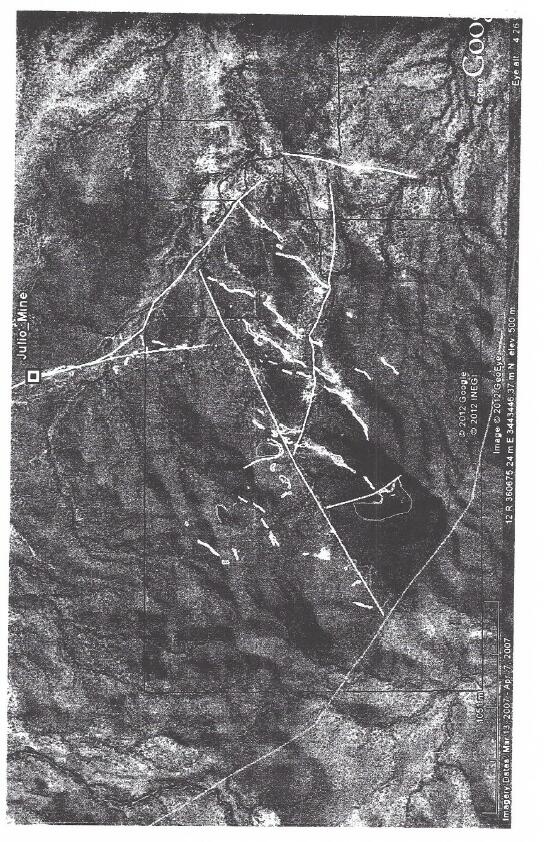
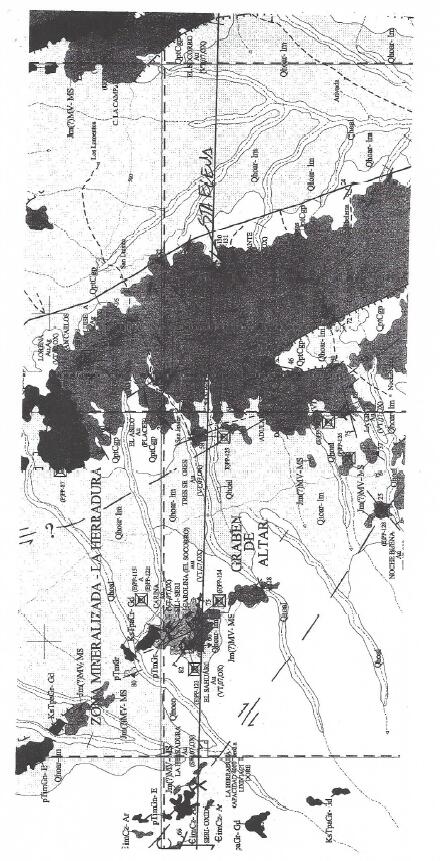
EXPLORATION.-
Small prospects on quartz veins, shafts to 30 meters depth and other small workings and extensive placer work in the whole area. Old bonanza findings as kilos of gold on selected veins shoots and shear zones.
No recent exploration or geological mapping has been directed. Limited examination and sampling was done during 1995 and 1998 TARGET.-
Bulk Au_Ag shear zone type mineralization combined with medium to high grade vein quartz, associated with the Mojave-Sonora megashear zone.
REGIONAL GEOLOGY.-
The area is in highly tectonized and within dynamically metamorphosed rocks as shists from volcanic flows and intrusive rocks such as an older medium grained to porphyritic granodiorite grading into hypabyssal rhyodacite porphyry to gneissic phacies apparently of Jurassic to Cretaceous age.
Parallel and conjugate structures to the main NW-SE tectonism , related to Mojave-Sonora Megashear are likely to be the hosts for latter tertiary mineralization as fissure quartz veins, and also low angle shear zones which are the best permeable conduits. Coincident structures are best targets in this area.
Host rocks in the area are Jurassic – (quartz feldspar porphyry )with some basalt cappings or rhyolite flows.
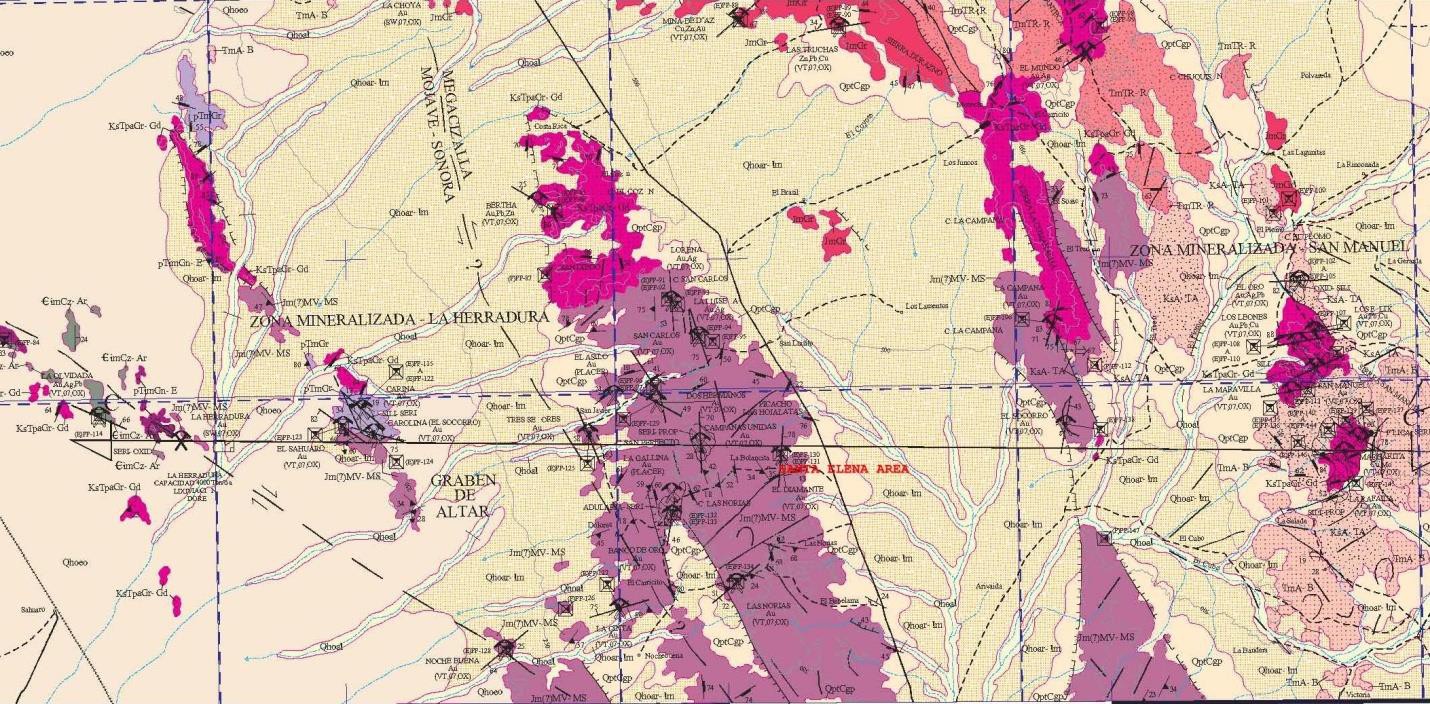
LOCAL GEOLOGY AND MINERALIZATION.-
Santa Elena area is dominated by a series of fissure white quartz veins where 6 important systems have been recognized in this stage hosted in moderately tectonized granodiorite mostly with some latter flow volcanic in the higher elevations as vesicular basalts.
3 or FOUR low angle shear zones are also present with important prospects in them and notable higher gold grades as bonanza pockets. These shear zones, contain gouge material mainly from granodiorite and accompanied by pyrolusite seams as an accessory mineral. Quartz veining is present as a carrier but not as the major constituent of the structure.
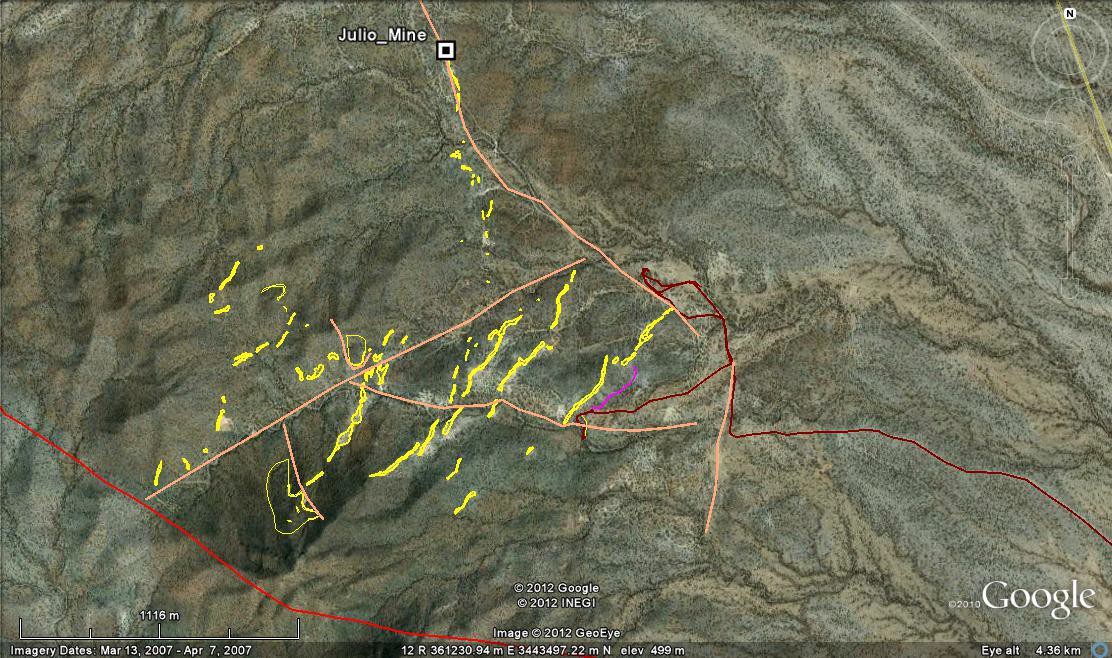
FISSURE QUARTZ VEINS.-
The fissure quartz vein systems have a general attitude of N33E and dip to the SE 60-70. They have a width average of 2.1 meters.
The quartz is massive and mostly fractured, and often brecciated due to multiple pulses during deposition.
They carry low sulphide content. Minor pyrite is present and mostly turned to hematite. Some malaquite after chalcopyrite is also common but not abundant.
The fissure quartz veins were deposited on tensional fracturing possibly created by the left- lateral movement on the major Mojave-Sonora megashear zone supposedly located only about 13 kilometers west of the area. These fissures have a conjugate attitude to the major trend.
The depth of the quartz vein depends on the brittleness of the host rock, in this case a granodiorite is a basement rock which is very homogeneous and can have constant brittle consistency for hundreds of meters as noted in the lengths observed on the surface. Quartz veins could attain depths to 1000 meters before they reduce to a tight fissure.
Although metal deposition is often zoned at depth controlled by the pressure - temperature conditions, it is known to have these zones extending for more than 1000 meters in depth.
At this stage we will have these possibilities open until some deeper drilling is directed.
LOW ANGLE SHEAR ZONES.-
Shear Zone 1 we can call the one coincident in part with the Julio Vein just south of the Julio Inclined Shaft. Detailed sampling will be carried out here to further study the shear zone.
Shear Zone 2 is recognized also coincident with a steep 0.50 m quartz vein at the “La Cruz” pit. More detailed sampling is required here as well.
Shear Zone 3, “La Bolsa” a 0.55 m thick shear zone with granodiorite on the base and capped by a foliated gneiss or cooked granodiorite. This shear zone appears mostly eroded and a cap still remains over a small hill with interesting grade history,(6 kg Manganese-Gold bonanza).
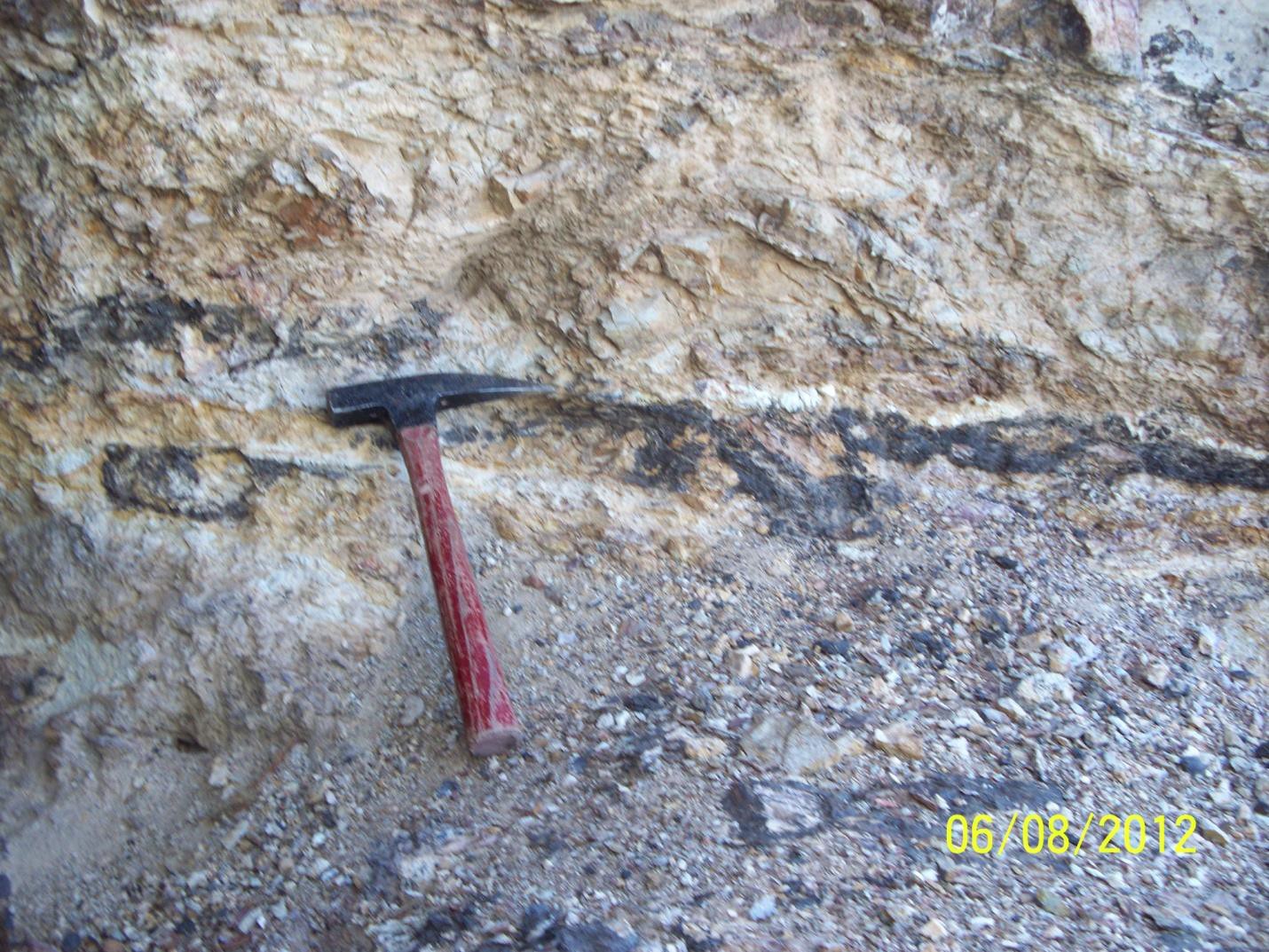
Shear Zone 4, on the SW area and NW hillside of the higher peaks in the area. This is a more extensive structure with 2.1 meters width, and with excellent tonnage possibilities as it is dipping into unknown and good host rock. This shear zone also shows pyrolusite –siderite seams where the old mining seemed to be concentrated on.
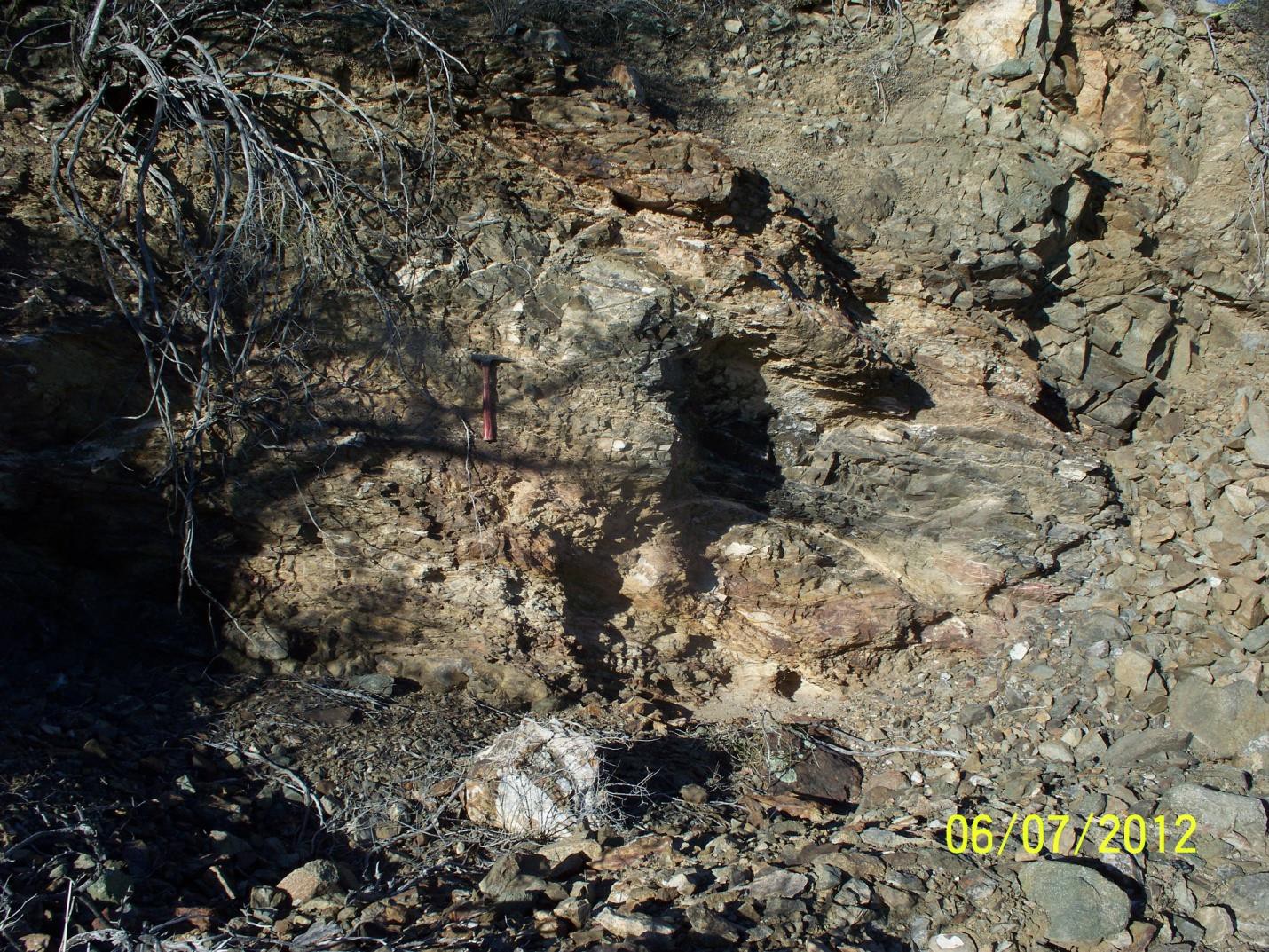
SAMPLING AND DATA AQUISITION.-
A 10 day GPS aided sampling – mapping program was directed starting where the outstanding white quartz veins are exposed. GPS tracking was done around the outcrops and latter unloaded into a topographic and satellite image as well. Satellite image was very useful in visually adjusting contacts of the quartz veins with the host granodiorite. GPS tracks and locations are then transferred into AutoCad format for precision plotting and usage of the data.
The result is a very precise outline of the quartz outcrops, enough to measure and handle as a geologic structure. Other features such as faults, shear zones, attitudes, observations are also picked up and recorded into the base map.
Chip rock sampling was done systematically at approximate 40 to 50 meter intervals along the structures, and picked up around a 5 meter radius from the location point, as to test the presence of Gold and Silver rather than channel for a local grade. Chips are sampled as to have a representative sample of the area around the location point.
Every sample location is recorded with a structure description, attitude and width. About 2 kgs of sample is collected in each station.
Samples are crushed to -1/2” and were split. About 1 kilogram of sample is sent to the lab and the rest is kept for storage. A standard or Duplicate sample was inserted every 20 samples approximately to assure quality control of the results for future use.
Samples are being sent to ALS-Chemex labs in Hermosillo for further prep and analysis in Vancouver, B.C., Canada. The analysis code for assay is ME-GRA22 which refers to a Au-Ag package using a 50 gr portion and fire assay.
164 samples were collected in this stage and 65 sent to the lab as of June 1 2012.
DATA .-
A sample list is produced and also converted to a access database to be used with 3D software in resource estimates and modeling.
The assay results are then fed into the database as they are received to be plotted and handled as to produce drilling targets or best production areas.
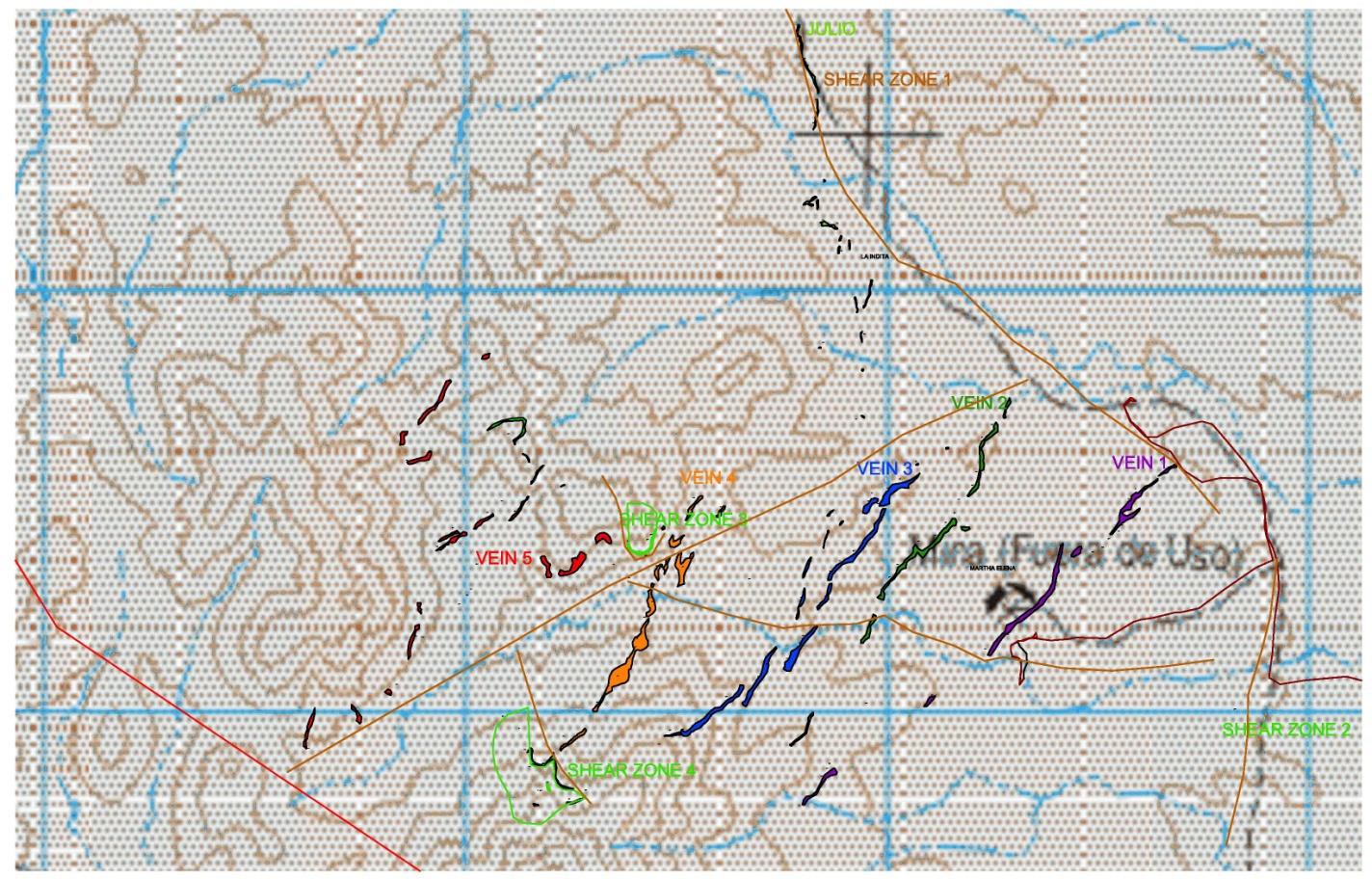
PRELIMINARY RESULTS FROM FISSURE QUARTZ VEINS AND SHEAR ZONES.-
Quartz vein structures are measured directly from plotted data and a specific gravity of 2.6 for calculations.
Shear zones 3 and 4 have a probable area determined by the structural geology. Drilling will also expand the volume estimates. A 2.4 specific gravity is used for the shear zone material.
Shear Zones 1 and 2 are undetermined at this stage. Ground EM would increase information on these concealed structures on the East area of the Property.
| QUARTZ VEIN AND SHEAR ZONE |
|
|
| ||||
Structure | total length | Area | width ave. | samples | Au | Ag |
|
|
VEIN _1 | 1192 |
| 3.48 | 3 - 28 | 0.93 | 1.6 |
|
|
VEIN _2 | 676 |
| 2.42 | 29-30,48-64 | 0.97 | 0.8 |
|
|
VEIN_3 | 954 |
| 1.98 | 31-47, 67-78 | 0.92 | 0.1 |
|
|
VEIN_4 | 682 |
| 5.4 | 81-93, 106,125-128 |
|
|
|
|
VEIN_5 | 176 |
| 1.25 | 116-119 |
|
|
|
|
VEIN_5 | 370 |
| 1 | 112-115, 132-138 |
|
|
|
|
VEIN_5 | 317 |
| 0.87 | 108-111 |
|
|
|
|
VEIN_5 | 304 |
| 1.8 | 141-145 |
|
|
|
|
VEIN_JULIO | 826 |
| 1.66 | 146-163 |
|
|
|
|
|
|
| 2.2 |
|
|
|
|
|
|
|
|
|
|
|
|
|
|
|
|
|
|
|
|
|
|
|
Shear Zone 1 | Julio |
| 3 | 148 |
|
|
|
|
Shear Zone 2 | La Cruz |
| 4 | 62 |
|
|
|
|
Shear Zone 3 | Bolsa | 7109 | 0.55 | 120-123 |
|
|
|
|
Shear Zone 4 | SW corner | 27509 | 2.1 | 96-104 |
|
|
|
|
|
|
| 2.4 |
|
|
|
|
|
PLACER POTENTIAL.-
As observed in the erosion of the quartz vein structures that have been subject to since their deposition and the faster and flatter, less competent shear zones possibly contemporaneous to the veins, it is reasonable to believe the shear zones have provided most of the gold in the rather recent alluvial deposits. It is evident that some of the placer gold comes from the quartz veins but apparently larger portions of shear zones to the west have been washed away.
As a guide to placer exploration it is important to keep in mind the fact that these shear zones might be the best placer gold producers.
FURTHER WORK RECOMMENDED.-
Depending on the assay results, there will be a zonation of values to design a drilling stage.
Core hole drilling is essential in providing structural and geological information in specific areas as well as proving continuity at larger depths.
Reverse circulation drilling is essential in obtaining best samples for the irregular behavior of gold values in quartz veins because of the sample size recovered and the drilling time.
Percussion track drilling for blasting will also be the optimal method of production and ore control.
Ground EM geophysics is crucial in following the concealed trace of the shear zones. An EM survey on the Julio and the La Cruz shear zones should be directed to be able to design a drilling program in this area.
Further mapping and sampling is also recommended to continue in areas not covered so far.
As sampling results come in, more detailed vein analysis will be done to direct further exploration.
Selected areas should be accessed with new roads in preparation for further exploration .
